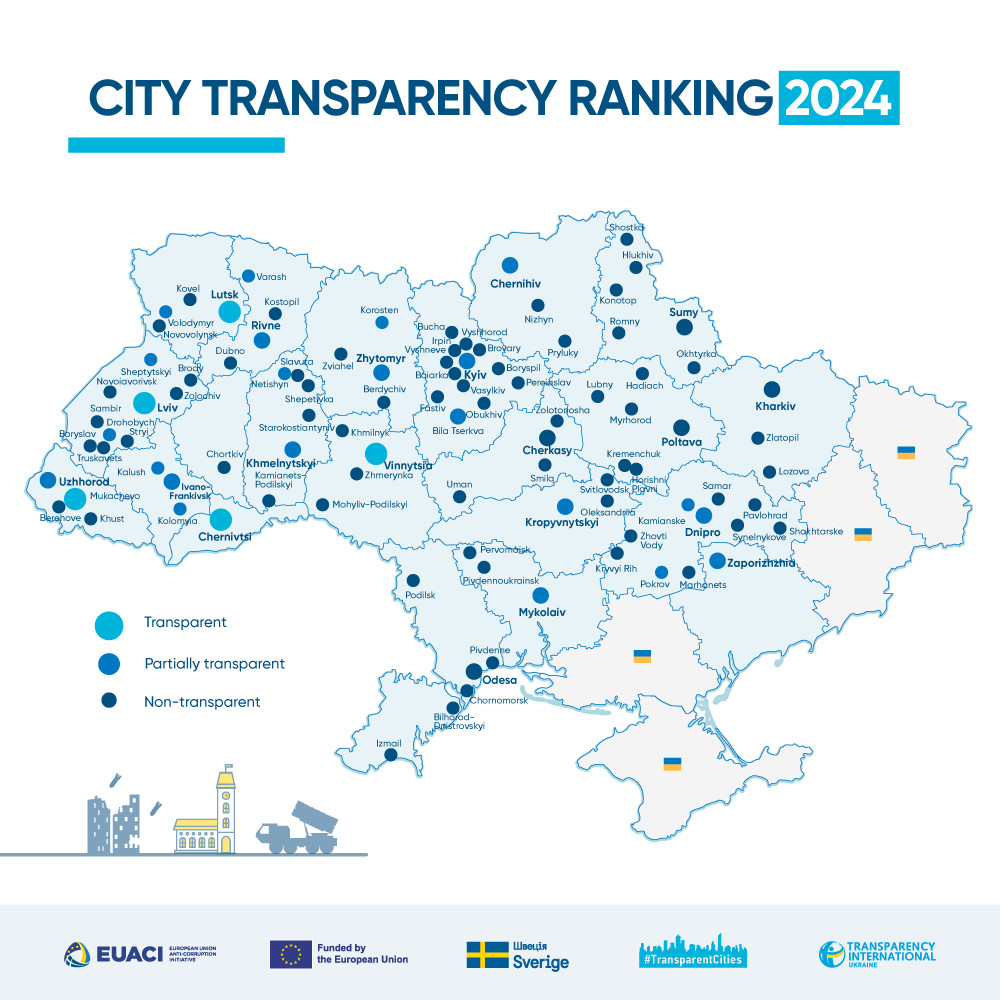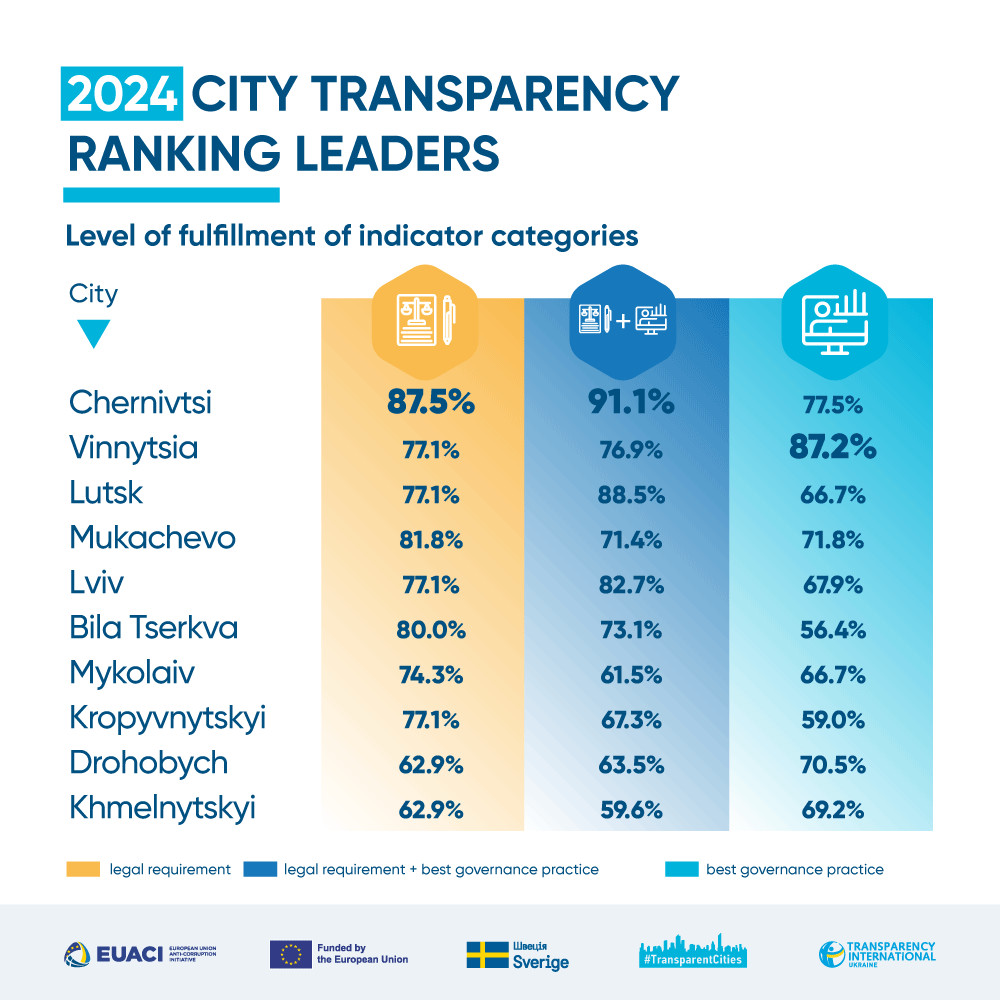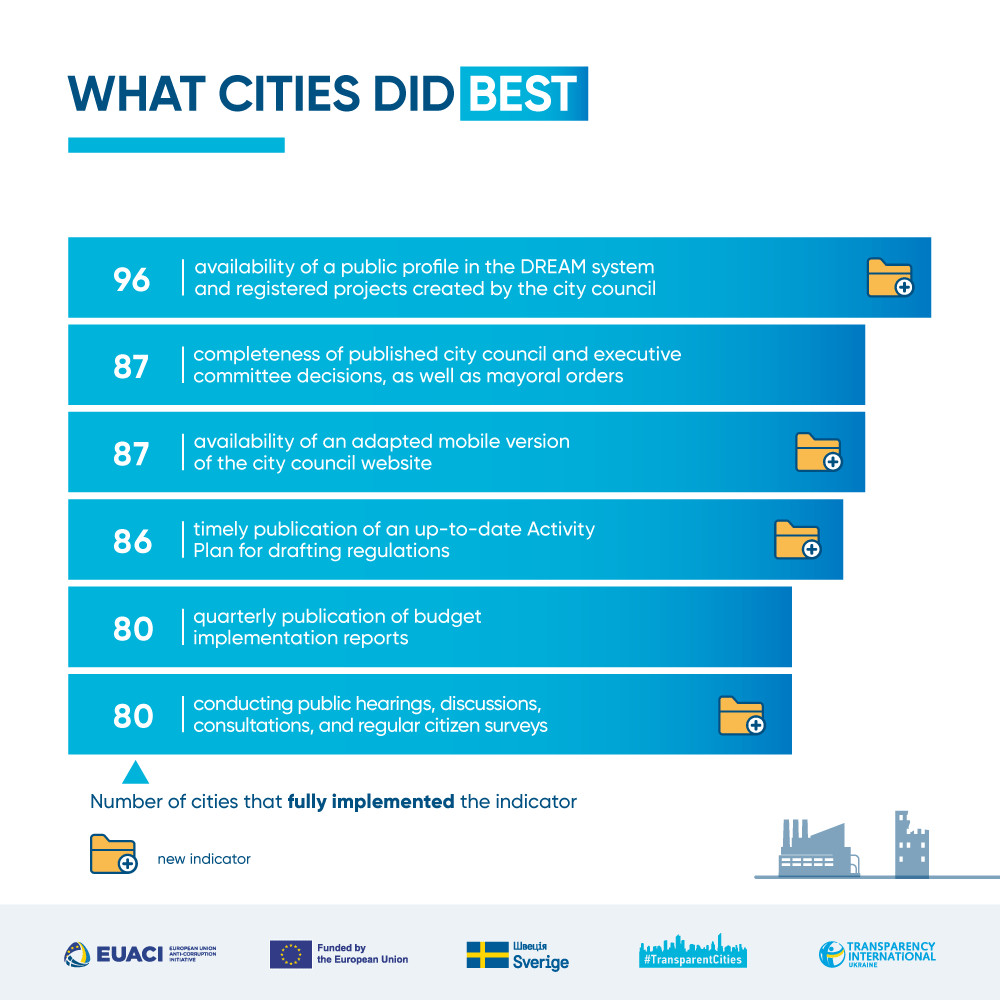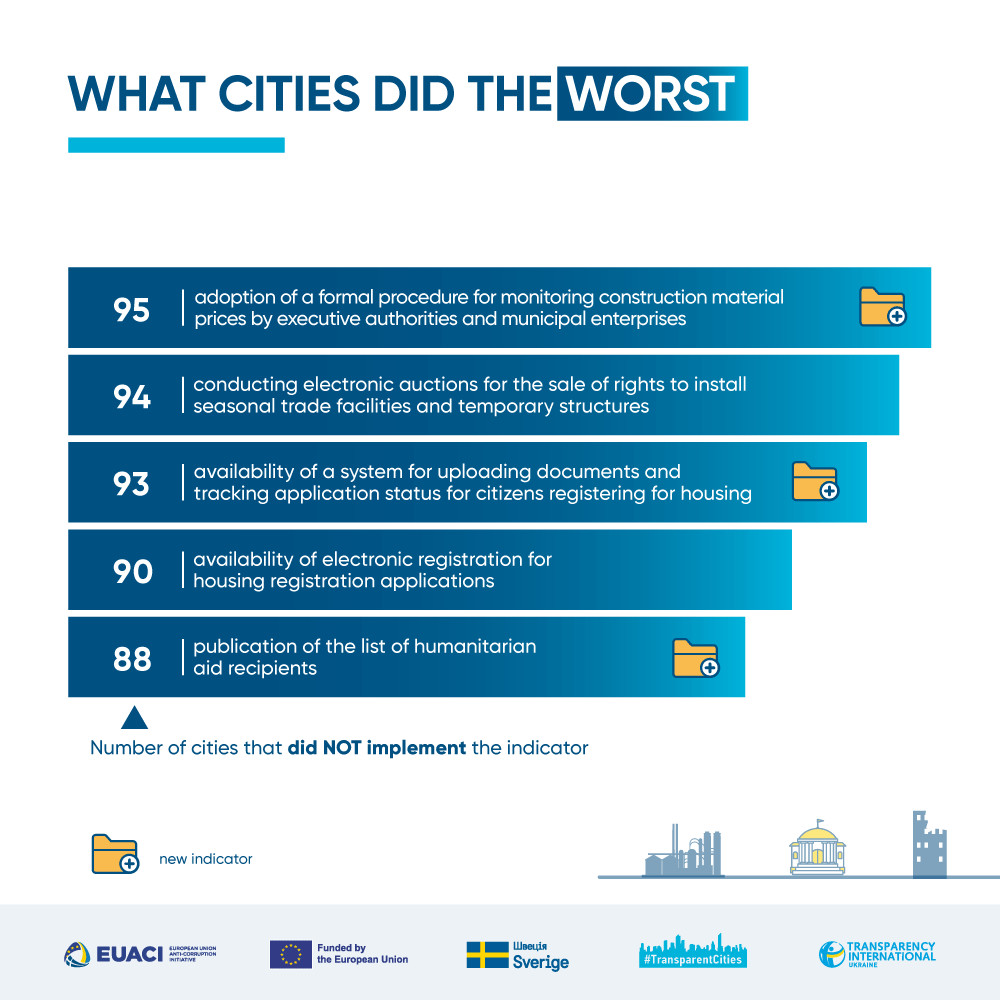Mukachevo and Lviv retained their “transparent” status, while Dnipro and Drohobych lost their leading positions and were downgraded to “partially transparent.”
These data were published by Transparency International Ukraine’s Transparent Cities program in its eighth study on the performance of 100 city councils across 21 regions.
In 2024, five cities became transparent. For the first time since the beginning of the full-scale invasion, Chernivtsi, Vinnytsia, and Lutsk joined the ranks of transparent cities, alongside 2023 leaders Mukachevo and Lviv. Twenty-two cities were classified as “partially transparent,” while the rest 72 did not reach the 50-point threshold and remained in the “non-transparent” category.

The ranking leader, Chernivtsi, scored 84.5 out of 100 points, demonstrating significant progress of 27 percentage points (hereinafter referred to as p.p.). Vinnytsia took second place with 81 points, while Lutsk came in third, also demonstrating significant progress—an increase of 20.7 percentage points—and earning a total of 76 points.
The top ten includes seven regional centers and three other cities. In addition to the five transparent cities, the list features the partially transparent Bila Tserkva (69 points), Mykolaiv (68 points), Kropyvnytskyi (67.5 points), Drohobych (66 points), and Khmelnytskyi (64.5 points).

The worst results were gained by Konotop (11 points), Mohyliv-Podilskyi (15.5), Zolochiv (16), Khust (16.5), Bilhorod-Dnistrovskyi (17.5), Pivdenne and Vyshneve (19.5 each), Samar (21.5), Hlukhiv, and Izmail (22.5 each). Half of these cities took part in the transparency study for the first time, while the remaining five had participated in previous assessments.
The average level of city transparency constitutes 41.6%. Cities that had performed well in previous years often continued to improve their transparency in 2024. Seven cities moved up a category: Vinnytsia, Lutsk, Chernivtsi, Varash, Zaporizhzhia, Kolomyia, and Slavuta. Over the past year, 37 city councils improved their transparency by 10% or more. However, some became less transparent: Dnipro and Drohobych lost their “transparent” status, while Berdychiv, Kovel, Odesa, and Shostka were downgraded from “partially transparent.”
The average transparency level of “frontline”* cities exceeds the overall average, reaching 43.9%. These findings once again demonstrate that proximity to the front does not prevent a city from developing and enhancing its transparency. The leading example among such municipalities is Mykolaiv, which significantly improved its performance, scored 68 points, and ranked seventh overall. Zaporizhzhia also demonstrated the most notable progress among all the cities studied, earning 63 points and rising to 12th place in the ranking due to a 27.3 percentage point improvement compared to 2023.
The most represented regions in the study were Kyiv (12 cities), as well as Dnipropetrovsk and Lviv regions (10 cities each). Of these, 11 municipalities from the Kyiv region and 7 each from the Dnipropetrovsk and Lviv regions were classified as “non-transparent.”
“Our eight years of research confirm that nothing influences the level of transparency more than political will and consistent efforts to improve the quality of life in cities. Even the number of air raid alerts does not correlate with transparency levels. The key to success is leadership, teamwork, and the determination to improve your community,” notes TI Ukraine’s Executive Director, Andrii Borovyk.
The results of the eight-year study show that city councils with lower transparency tend to lack consistency and sustainability, making it more difficult for them to withstand the challenges of war.
Across all areas, cities demonstrated the strongest performance in indicators related to openness (43.6%), public relations (41.7%), and response to war-related challenges (39.6%).

The majority of assessments were marked as “not implemented” in the areas of citizen services (67%), municipal property and land management (61.1%), and HR policy and integrity (60.3%).

For the first time in the program’s history, during the preparation of the 2024 Transparency Ranking, Transparent Cities decided not to assign a ranking or status to a city. This decision was made in response to the deliberate manipulation of publications on the official website of the Ternopil City Council, the provision of false information, refusal to acknowledge errors, and unacceptable communication regarding the issue.
This research was prepared within the framework of the institutional development program of Transparency International Ukraine, implemented with financial support from Sweden and the European Union Anti-Corruption Initiative (EUACI) — an anti-corruption program funded by the EU, co-financed and implemented by the Danish Government.
The research outcomes are the responsibility of the authors and do not necessarily reflect the views of the EU or the Governments of Sweden and Denmark.
Transparency International Ukraine is an accredited chapter of Global Transparency International. Since 2012, TI Ukraine has been helping Ukraine grow stronger. The organization takes a comprehensive approach to the development and implementation of changes for reduction of corruption levels in certain areas.
TI Ukraine launched the Transparent Cities program in 2017. Its goal is to foster constructive and meaningful dialogue between citizens, local authorities, and the government to promote high-quality municipal governance, urban development, and effective reconstruction. In 2017–2022, the program annually compiled the Transparency Ranking of the 100 largest cities in Ukraine. After the full-scale invasion, the program conducted two adapted assessments on the state of municipal transparency during wartime. In 2024, the program resumed the creation of the transparency ranking for 100 cities and launched a new study, “Open Data Pulse: Ukrainian Cities Ranking.” The program produces high-quality analytics on various aspects of government-citizen interaction, as well as transparency and accountability in Ukrainian cities. This includes, in particular, processes such as decolonization, housing policy, and more.